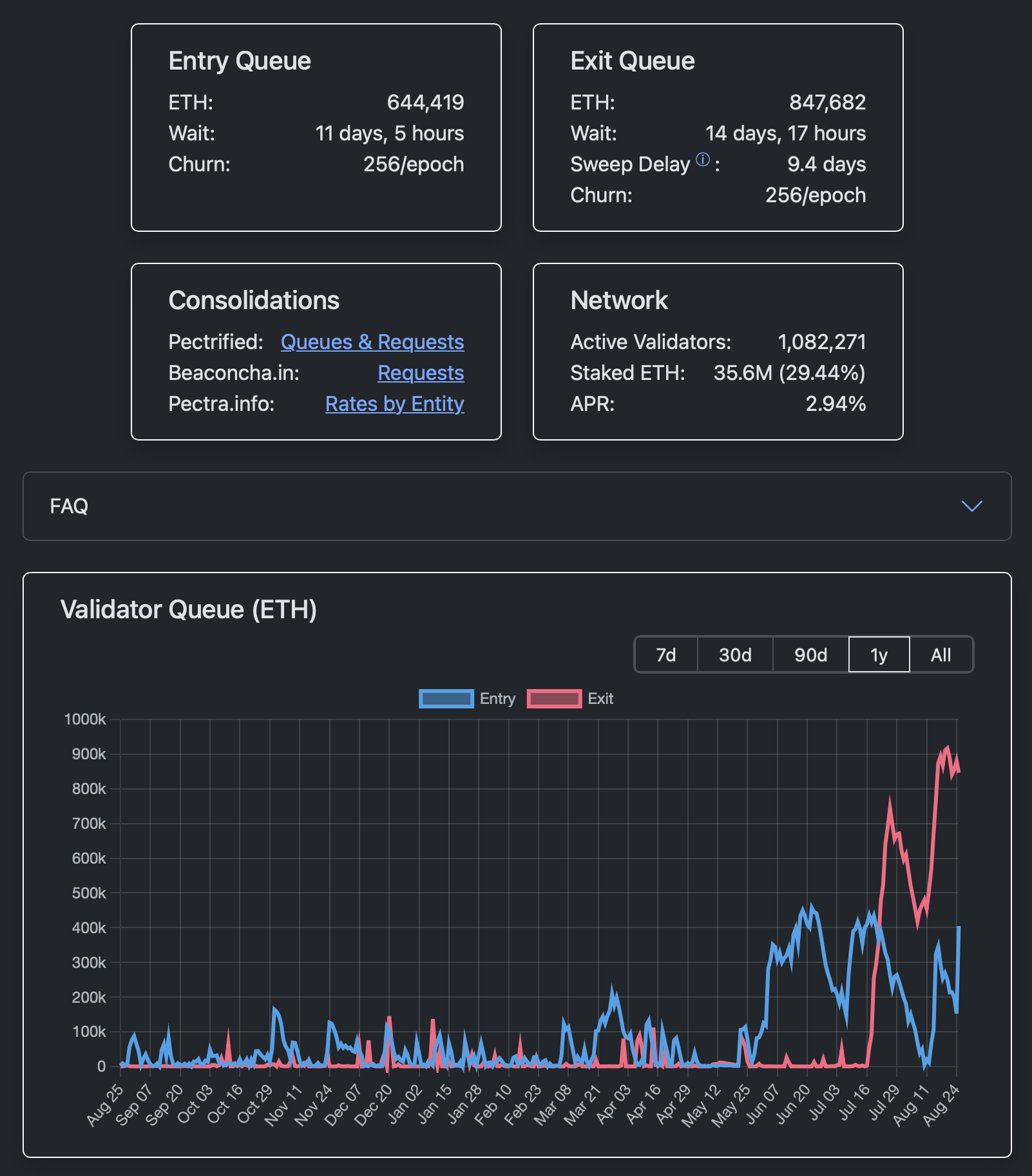The Ethereum validator queue is a backlog of deposit requests to become ETH validators; it recently surged to over 644,000 ETH (~$7 billion), pushing average staking wait times past 11 days and signaling mixed sentiment among large ETH holders between profit-taking and long-term staking.
-
$7B in staking liquidity is waiting to enter or exit the ETH staking system
-
Validator entry queue topped ~644,000 ETH; unstaking queue eased from ~970,000 to below 850,000 ETH
-
Staking annualized rewards slipped below 3%, down from typical ~4% as validator count grows
Ethereum validator queue surges to 644K ETH and $7B in limbo — read the latest wait-time data, staking reward impact, and what large wallets mean for ETH price action. Learn more.
Published: 2025-08-22 · Updated: 2025-08-25 · By: COINOTAG
What is the Ethereum validator queue and why does it matter?
The Ethereum validator queue is the backlog of deposit requests from addresses that want to become ETH validators. A surge in the queue increases average wait times to join the staking set and reflects competing flows: some wallets staking for yield and others unstaking to realize gains.
How large is the current ETH validation backlog and what are the numbers?
Over the past two days the entry queue added more than 400,000 ETH, peaking above 644,000 ETH. Simultaneously, the unstaking queue, after an Aug. 20 spike near 970,000 ETH, has calmed to below 850,000 ETH.
Combined, about $7 billion worth of ETH is waiting to either join or leave staking — a raw liquidity measure showing mixed expectations among large holders.
How long are ETH validators waiting to be processed?
As queue size rose, the estimated time to activate or withdraw validator stakes increased to over 11 days. This is measured by validator turnover and current throughput of the Ethereum consensus layer.
Longer wait times can discourage small participants and temporarily tighten liquid supply, which may amplify short-term price moves.

Image by Validator Queue
Why are staking rewards falling and what does that mean?
Increased validator supply has reduced annualized staking rewards below 3%, down from around 4% historically. Lower yields reduce the immediate incentive to stake new ETH for passive income.
Reduced rewards and longer lock-up periods may tilt some holders toward withdrawal to secure profits or rebalance portfolios.
When did price action interact with staking flows?
Recent price moves produced debate over a new Ether all-time high. Some platforms reported a fresh ATH last Friday, while CoinGecko and CoinMarketCap (plain text) did not confirm surpassing the 2021 high.
Profit-taking around elevated prices likely contributed to the Aug. 20 unstaking spike, while renewed conviction led others to join the entry queue.
Frequently Asked Questions
How does the validator queue affect ETH liquidity?
When the entry queue grows, ETH becomes effectively less liquid because newly queued deposits delay validator activation. Conversely, a large unstaking queue signals available supply that may hit markets once withdrawals are processed.
Can staking rewards recover if the queue stabilizes?
Yes. If the validator entry rate slows or if unstaked ETH returns to liquidity, validator rewards can rise as fewer new validators dilute rewards. Rewards depend on total staked ETH and network issuance metrics tracked by the Ethereum Foundation (plain text).
Key Takeaways
- Queue size: >644,000 ETH in the entry queue and ~850,000 ETH in the unstaking queue indicate ~ $7B in transitional staking liquidity.
- Wait times: Average activation/withdrawal now exceeds 11 days, raising short-term liquidity risk.
- Market signal: Mixed flows—some large wallets lock ETH expecting further gains while others withdraw to lock profits—creating ambiguous price implications.
Conclusion
Rising pressure in the Ethereum validator queue and changing staking rewards reveal a tug-of-war between profit-taking and long-term staking conviction. Monitor queue size, estimated wait times, and staking APRs to gauge near-term liquidity and sentiment. For ongoing updates, rely on official network metrics and recognized market trackers.







